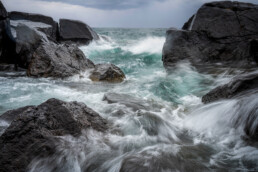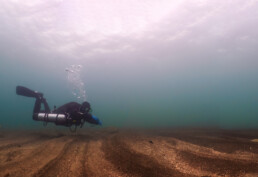Into the Blue... sometimes brown. Adventures for the Winter Weary.
There’s a particular flavor of malaise that creeps in around late January. The kind that makes your brain feel like a poorly tuned piano—flat, dissonant, vaguely irritated by everything. Here in northern Minnesota, where winter hangs on like a party guest who didn’t get the hint, this feeling can settle in somewhere between your collarbones and stay there until the ice melts.
So what’s a person to do? Therapy is great. Vitamin D helps. So do martinis. But for me, the real answer has been a little less clinical, a little more neoprene-clad: I go diving.
Now, this wasn’t always the plan. Diving in winter—particularly in the less-than-tropical waters of Lake Superior—sounds like something you’d try once and never speak of again. But this year, my dive buddy Heather and I have been getting in the water weekly, and against all odds, it’s been… joyful. Not just bearable. Not just “hey we survived that.” But actual fun. A surprising, giddy sort of fun that leaves you wondering if maybe you’ve finally gone properly off your rocker. But in a good way.
Take today, for example.
Thursdays are a usual dive day. Nature, however, had planned something else—a misty, on-and-off rain, some half-hearted snowflakes, and a stiff northeast wind (exactly what you don’t want if you fancy calm water on Lake Superior). Still, the adventure of diving is a powerful motivator, so we met up at Burlington Bay anyway, hoping that a beach entry would offer some sure footing against the sturdy surf.
To our surprise, the entry was smooth—no running, no tripping and no errors. In cold-water diving, with heavy, gear, and thick gloves that’s no small feat. Conditions often conspire against you: sticky zippers, free-flowing regulators, or a poorly timed wave just as you’re sealing your mask. But today, everything clicked. We dropped beneath the surface quickly and cleanly, which, in winter diving, feels like a small victory in itself.
Underwater, though, was a different story. Visibility was laughable. Imagine trying to swim through a bowl of soup while someone gently shoves you side to side. The surge was strong, the silt was thick, and the vertigo came in waves—literally. At one point, I found myself giggling into my rebreather loop like a kid on a tilt-a-whirl. It wasn’t graceful, but it was weirdly delightful. Maybe it was the absurdity of it all. Maybe it was my brain short-circuiting from the mismatched sensory input. Either way, I was enjoying myself.
And then, as if by magic, we swam through what felt like an invisible curtain. On one side: murk. On the other: clarity. Visibility suddenly jumped to twenty feet or more, and Heather and I exchanged that special kind of diver look—the underwater equivalent of “can you believe this?!”—followed by the classic OK sign, which in this context meant “This is unexpectedly lovely.”
The dive itself was uneventful (again, in the good way), but by the time we surfaced and made our way back to the car, we were cold but buzzing. We stood there in our drysuits, sipping tea and laughing about how this crazy winter diving thing had turned into something to look forward to and therapeutic.
Heather mentioned how much it’s helped her this winter. That she usually gets hit pretty hard with seasonal depression, but the weekly dives have been a significant light through the long, gray months. I nodded, probably more than necessary, because I knew exactly what she meant.
I’ve always believed in the idea of “everyday adventure.” It’s a big part of why I love to dive, and why I ride my bike to work every day—rain, shine, snow, or sideways sleet. Most days it’s just a commute, a predictable pedal down the same streets. But every once in a while, Mother Nature shows up with a little spice—icy roads, freezing fog, or a foot of snow —and suddenly it’s not just a ride. It’s an adventure.
And adventure, I’ve come to believe, is a kind of medicine.
There’s science behind this, of course. Studies show that physical activity, especially outdoors, can boost serotonin, lower cortisol, and improve mood. Nature exposure has been linked to reduced anxiety and increased cognitive function. And diving? There’s evidence that the slow, deep breathing and sensory immersion can have a calming, almost meditative effect on the brain.
But beyond the data and the pie charts, there’s the undeniable truth of it: getting outside, moving your body, doing something just a little bit brave—it helps. Not in a dramatic, fireworks-and-trumpets kind of way, but in the quiet, reliable way that brushing your teeth helps prevent cavities. You don’t always notice the effect immediately. But miss it for too long, and suddenly your smiles are sepia-toned.
So no, diving didn’t solve all my problems. It didn’t pay my bills or make February shorter. But it gave me something to look forward to. It gave me a reason to get out of bed on gloomy Mondays, to stuff myself into a drysuit and plunge into cold water like some sort of well-insulated lunatic. And more than anything, it made me smile. Which, in the dark heart of winter, is no small thing.
So here’s to everyday adventure. To murky water and clear minds. To wind in your face and snowflakes in your eyelashes. To laughter in the surge and coffee (or tea) in the cold. It’s not always pretty. It’s not always comfortable. But it is, almost always, worth it.




